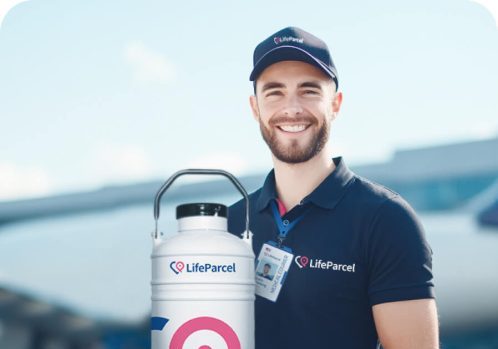What really happens when your embryos, eggs, or sperm need to travel? Here’s what a typical day looks like for a fertility courier at LifeParcel—and why every detail matters when you’re carrying someone’s future family.
At 5:47 AM, Sarah’s phone buzzes with a mission update. She’s been a LifeParcel courier for three years, and today she’s carrying embryos from a clinic in New York to a hopeful couple’s fertility center in Miami.
As she reviews the details over her morning coffee, Sarah knows this isn’t just another delivery. Somewhere, a couple who’s been trying to conceive for years is counting on her. Maybe they’ve been through multiple failed cycles. Maybe this is their last chance with these particular embryos.
She doesn’t know their full story, but she carries their hopes as if they were her own.
6:30 AM: Preparing for the mission
While most people are still sleeping, Sarah is already at our facility conducting what we call the “pre-flight ritual”—though it’s anything but routine.
First, she inspects the cryogenic shipper that will become her constant companion for the next 12 hours. The tank is already filled with liquid nitrogen and holding steady at -196°C, but Sarah checks the temperature logger anyway.
The paperwork comes next—customs forms, clinic authorizations, transport permits. Each document has been triple-checked by our team, but Sarah reviews every line. One missing signature could mean delays. Delays mean temperature fluctuations. Temperature fluctuations could mean…well, she doesn’t let herself think about that.
9:15 AM: Handoff at the clinic
Sarah arrives early at the fertility clinic. She’s been here before, but it still strikes her how different it feels from a regular medical office. There’s a weight to the silence, a sense of anticipation that seems to hang in the air.
Dr. Martinez, the embryologist, meets her in the lab. He’s been working with these embryos for months—monitoring their development, carefully selecting the most viable ones, preparing them for this moment.
“Patient ID 47291, five-day blastocysts.” he says, showing Sarah the labels.
She nods and begins the chain of custody process. Photo documentation of the specimens. Verification of the patient ID against her transport documents. Temperature check. Signatures from Dr. Martinez confirming the transfer.
The handoff process is thorough but efficient. Dr. Martinez walks through each verification step, ensuring nothing is missed before the specimens leave the clinic’s care.
10:00 AM: En route to the airport
With the specimens secured in her temperature-controlled tank, Sarah begins the journey to JFK. This seemingly simple part of the process requires careful planning—she’s mapped out the fastest route while avoiding roads with excessive vibration or construction delays that could affect the tank.
The cryogenic shipper sits secured in the back seat, where she can keep a constant eye on it. Sarah monitors the digital readout on her dashboard-mounted logger, watching for any deviation from the required -196°C.
Traffic is heavier than expected, but careful planning with plenty of buffer time means there’s no cause for concern. Still, Sarah checks her flight status on the airline app and alerts the Miami clinic about her departure time. Communication is constant throughout every step.
11:45 AM: Why we never ship—we chaperone
At TSA, Sarah presents her pre-approved documentation for transporting medical specimens. The cryogenic shipper requires special handling—it can’t go through standard X-ray screening, which could potentially damage the genetic material inside.
The TSA officer is skeptical about the unusual tank and wants to hold it for additional screening. Sarah remains calm—she’s encountered this before. Her training kicks in as she professionally explains the pre-clearance documentation and why the tank requires constant supervision due to the liquid nitrogen inside.
After reviewing the paperwork and consulting with a supervisor, the officers conduct their manual inspection of the exterior tank. The process takes about 15 minutes—longer than usual, but Sarah’s experience in handling these situations prevents any escalation. The specimens remain sealed and undisturbed throughout.
This is exactly why LifeParcel uses hand-carry service rather than commercial shipping—your materials stay under direct supervision, and our couriers know how to navigate regulatory challenges that could rattle an inexperienced courier.
2:20 PM: When things don’t go according to plan
The Miami flight is delayed. Then delayed again.
This is where Sarah’s training kicks in. She immediately calls our 24/7 support team and the receiving clinic to update them on the situation. She checks the tank’s hold time (18 days remaining—plenty of buffer) and continues monitoring the temperature readings frequently.
Sarah remains calm despite the delays. This is exactly why LifeParcel plans for worst-case scenarios—the tank is designed for extended transport times, and our couriers are trained to handle unexpected situations. The receiving clinic stays informed, and the logistics complications are handled professionally without creating additional stress.
8:30 PM: A change of plans
As Sarah exits Miami International, she’s already received updates from the LifeParcel team. They’ve been in communication with the receiving clinic about the delayed arrival and have rescheduled delivery for first thing tomorrow morning.
Sarah checks her transport details one more time. The embryos aren’t scheduled for transfer until next week, and her tank is holding steady at -196°C with 18 days of buffer time remaining. The overnight delay poses no risk to the specimens.
This kind of proactive coordination happens regularly when flights get delayed or scheduling changes occur. The LifeParcel team handles all the logistics communication so Sarah can focus on specimen safety, and the equipment is designed for these contingencies.
Sarah heads to her hotel, knowing her cargo is secure and tomorrow’s delivery is already arranged.
9:00 AM (next day): The moment that matters most
At the Miami clinic, Sarah feels the familiar sense of responsibility that comes with every delivery. Dr. Patel meets her at the lab entrance, and they begin the final transfer process.
Temperature check: -196°C steady throughout transport.
Chain of custody documentation: complete and signed.
Specimen verification: Patient ID 47291 confirmed.
But for Sarah, the real confirmation comes when Dr. Patel examines the embryos under the microscope.
“Perfect condition,” he says. “They traveled well.”
Sarah nods. Another successful transport completed. The couple will receive confirmation that their embryos arrived safely and are ready for transfer.
More than a job
With the delivery complete, Sarah has a few days in Miami before her return flight. Most LifeParcel couriers use the downtime to explore the destination city.
As she settles into her hotel, Sarah reflects on what makes this work meaningful. There’s definitely pressure in transporting irreplaceable genetic material, but there’s also clarity of purpose. She’s ensuring that months of medical treatment and significant financial investment don’t get derailed by transport issues.
Every couple LifeParcel serves has already committed substantially to get to this point—time, money, and emotional energy. By the time they need courier services, their embryos or eggs represent months of preparation and treatment. Professional, reliable transport is what they deserve and what their situation demands.
Why your courier matters more than you think
When you’re researching fertility transport services, it’s easy to focus on technical specs—temperature control, success rates, logistics capabilities. Those things matter, and they matter a lot.
But what today’s journey reveals is that the human element matters just as much. Your courier does more than maintain -196°C and follow checklists. They navigate TSA complications, handle flight delays, and coordinate with clinics—all while ensuring your irreplaceable genetic material never leaves their sight.
At LifeParcel, we seek out couriers who want meaningful work, then train them rigorously so every mission succeeds. Because when you’re entrusting someone with months of medical investment and hope, you need both flawless execution and someone who truly gets what’s riding on that tank.
Want to take the stress out of IVF transport? Request a quote or call us at +1-866-370-6577.





